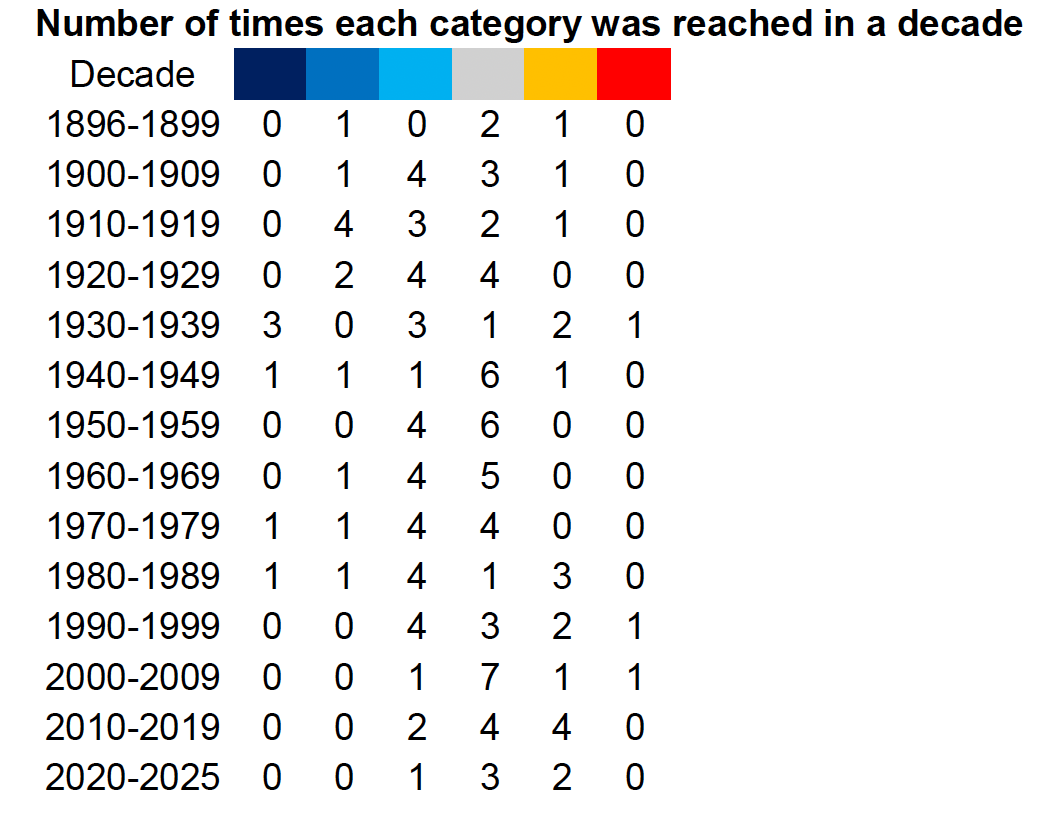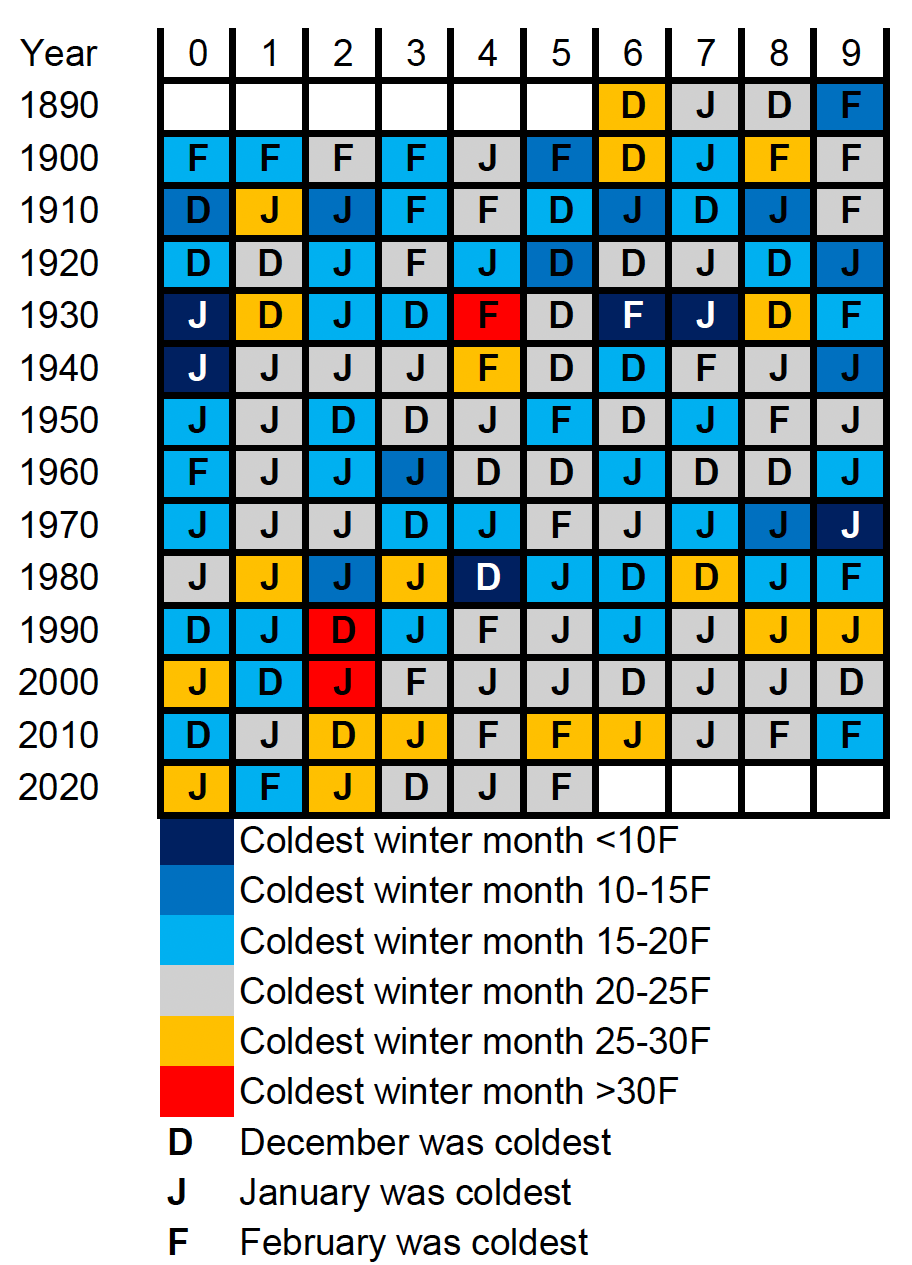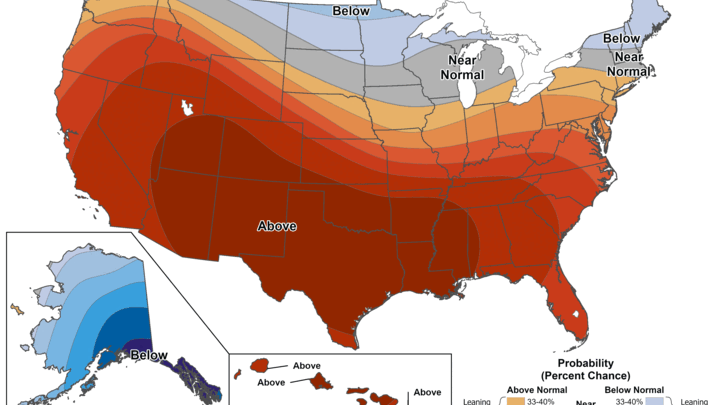January typically coldest
Climatology from NCEI's Climate at a Glance shows that January is the coldest winter month in Nebraska with an average temperature 22.1°F followed by December (25.3°F) and February (26.7°F). But some years the temperatures in a winter month are much colder or warmer than average and January is not always the coldest winter month. We decided to do a short study to determine how often each winter month was the coldest and how cold that month was. Figure 1 (below) shows that while January has been the coldest month most often since 1895, both December and February have had their fair share of being the coldest winter month of the season.
Before getting into the meat of the article, there are some important notes we want to clarify:
1) All temperatures referred to in this article are statewide averages. Temperatures may have been colder or warmer at some spots in the state.
2) Where temperatures for December are the coldest, they are identified by the winter season they are associated with and not the calendar year it occurred. For example, December 2022 was the coldest month in the 2022 calendar year but is credited to 2023 since it occurred during the 2023 winter.

Figure 1. Color wheel showing the categorical range for the average temperature for the winter month that was coldest for a particular winter season. How to read: A stripe appears in the section of the circle labeled for January if January was the coldest month and the color corresponds to the temperature range in the upper right of the figure. Same story for both February (bottom left) and December (top). The winter seasons range from 1896-2025 and the years get later the further away you get from the center of the circle.
Warming trend
Figure 1 also shows that the coldest winter month is generally warmer now than it was for most of the 20th century when blue stripes representing average temperatures below 20°F were common. This is most apparent for January, which hasn't had an average temperature below 20°F since 1996. The coldest winter month has had an average temperature below 20°F multiple times since 1996 but it has happened either in February or December. This happened most recently in February 2021 during a period of polar vortex stretching which brought record cold to the central U.S. More on February in a little bit.
While temperatures in the 15-20°F (light blue) category have occurred in the last decade, the very cold winter months (<15°F; represented by dark blue and blue categories) have disappeared since the early 1980's. The last winter month in the dark blue category was December 1983 (counted for the winter of 1984) and the last month in the blue category (15-20°F) was January 1982. There was not a gap longer than 14 years between winter months in one of the coldest two categories prior to the current gap, which now is over 40 years.
It is not impossible to have a future winter month with temperatures where temperatures average below 15°F in Nebraska. But it is much more unlikely than it was for most of the 20th century. The last few winters are a case in point. Both January 2024 and February 2025 had record or near-record cold stretches in them and neither finished with a statewide average temperature below 20°F, much less finishing below 15°F. In both cases the days that weren't very cold were generally mild compared to the long-term historical averages, so the monthly average temperature overall wasn't exceptionally cold.
Variability
This figure also shows that though there is a pronounced warming signal in our winter, there are certainly examples in the late 19th and the first decades of the 20th century where the coldest winter month was quite mild (shown in yellow and red). So warmer winters were not unheard of prior to the 1990's, they just were less common than now. Some other interesting points regarding variability:
1) Figure 2 shows that there are periods of time with low and high year-to-year variability in how 'cold' the coldest winter months are. The 1940's to the 1960's generally were consistent in the 15-20°F (light blue) and 20-25°F (gray) categories. The coldest winter month in the 2000's was in the 20-25°F category for several straight years. Conversely the 1930's and 1980's into early 1990's had high variability with some years having a very cold winter month (< 10°F; dark blue) or cold (10-15°F; blue) for its coldest winter month in a season and others having a mild or very mild month for its coldest winter month in a season. For example, February 1934 came in as the coldest month that winter with an average temperature of >30°F (red) and February 1936 came in with an average temperature in the single digits (dark blue). The winters in the 1910's and again in the 1970's were generally quite cold.

Figure 2. Categorical counts of the coldest winter month in each decade. Categories as follows: Dark blue (<10°F), blue (10-15°F), light blue (15-20°F), gray(20-25°F), yellow/orange(25-30°F), red(>30°F).
2) While January has been the coldest winter month most often (~50% of the time), there have also been periods when either February or December was the most common coldest winter month for a season. February was the coldest winter month quite often between 1900-1914 and has been the coldest winter month more frequently since 2014. But there have been large stretches (e.g., 1961-2003) where February was rarely the coldest winter month. December was commonly the coldest winter month in the 1910-1920's, 1950-1960's, mid 1980's to early 1990's, and in the first decade-plus of the 21st century.

Figure 3. Table showing the categorical temperature of the coldest winter month by season.
Cold and warm extremes occurred in each calendar winter month
Each winter month has at least one occurrence in all six temperature categories. Furthermore, each calendar winter month has representation in the coldest and warmest categories. In other words, the coldest winter month where temperatures were below 10°F has occurred in December, January, and February and the coldest winter month where temperatures were above 30°F has also occurred once for December, January, and February respectively.



